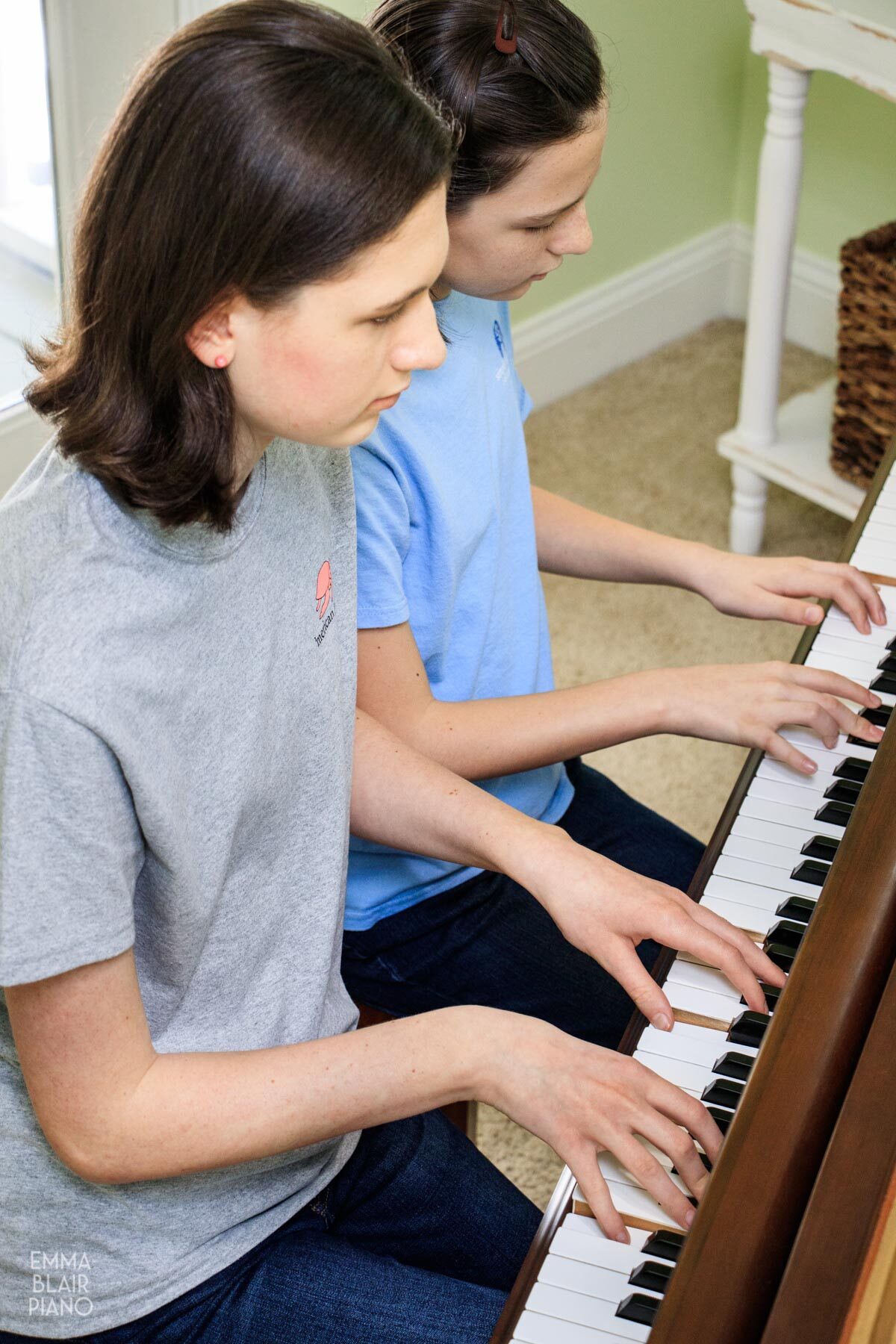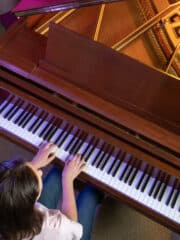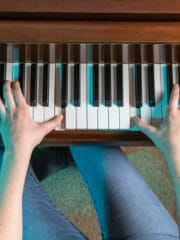If you've been a piano student even for a short time, your teacher will eventually ask you to play a duet. Although it might be scary to play the piano simultaneously with someone else, it will really help you improve your sense of rhythm, timing, and expression. Plus, you'll have a lot of fun playing with another musician and creating beautiful music on the piano!
Are you starting to learn a duet piece? Get my tips for choosing the right piano music for you and how to learn your song quickly.

Preparation
Choosing the Right Duet
It can be challenging to find a fun duet that's at the right difficulty for you and your duet partner. When looking for a piece, go through the following checklist to evaluate if it's a good fit for both of you.
- Is it slightly easier than the solo pieces we usually play?
- If my duet partner and I am at two different levels in piano, is this piece easy enough for the less experienced pianist? (Or in the case of a teacher-student duet, is the student part at the student's level?)
- Do both of us like this song?
- Am I willing to invest the time practicing my part, both on my own and with my duet partner?
Keep in mind that there are two types of duets: equal part ones and unequal part ones. Equal part duets mean that the primo and secondo parts of fairly equal difficulty, while unequal duets mean that one part is significantly easier than the other. Most duets for a student-teacher combo are unequal, while duets for two students typically are equal.
Primo or Secondo?
The part of a duet that contains the melody of the piece is called the primo, while the most of the harmony/accompaniment comes from the secondo part. The person playing the primo will usually play above middle C and will sit on the right side of the piano bench, while the secondo will usually play below middle C and will sit on the left side of the piano bench.
Many times, the primo or secondo parts present different technical challenges, and one part might be more suitable for one person than the other. If you don't know whether you should play the primo or secondo, ask your piano teacher for advice, or ask your duet partner which part they would like to play.
Keep in mind that younger students normally play the primo, as it is easier for them to grasp the melody of the piece rather than the accompaniment. The secondo part typically doesn't carry the melody except for a line or two, and it can be more boring to learn as a result. Personally, I prefer playing the secondo part in a duet, as it enriches the piece's overall sound.

Playing from the Book or Photocopy
Most music books are stapled together so they lay flat on the piano's music stand. However, it can be difficult to turn pages quickly in this type of book, especially if the pages stick to each other in a humid place, and the breeze from a fan or air conditioner can blow the pages willy-nilly, causing you to lose your place. Turning the pages too forcefully can even cause the book to fall off the music stand during the piece.
What I've discovered to be a wonderful solution is simply to photocopy the duet music, put the music in page protectors, and put the plastic-covered pages in a binder. It's easy to grip the plastic-covered pages, and since they're in a binder, they're quick to turn, and the binder lays flat on the music stand. The heavier weight of the page protectors prevents drafts from blowing the music around the room.
For an even more professional look, use a large tablet, such as the iPad Pro, to display your duet music. Turn the tablet on its side (landscape orientation) to fit two pages of music on the screen at once. Make sure to download the amazing ForScore app to display and edit your sheet music, and get an AirTurn Duo Bluetooth pedal to seamlessly turn the pages with your foot.
Practice
Learn Your Part Independently
This is the first step in learning a piano duet, and is definitely the most important. You won't be able to play the duet successfully with your partner if you can't play your part perfectly by yourself. Start with slow, careful practice, and work through your part until you know the whole piece. Use these practice tips to help you learn your part of the duet quickly, easily, and accurately.
Count Diligently
Count aloud when you play your part by yourself. When you start playing with your duet partner, you both should count aloud to help both of you match your parts up correctly. While this seems like a lot of work, and can make you out of breath, it will make it easy to see where one of you slows down, speeds up, or skips something.

Practice Together Slowly
Once both of you know your parts independently, it's time to put them together. Start by working on the first line (or the first page, for more advanced students), counting aloud and playing at a very slow tempo. If it sounds horrible, don't worry; learning the first line is always the hardest, and soon both of you will catch on. Stick with it!
Page Turns
Unless you're using a tablet and Bluetooth pedal to turn your sheet music, someone will have to reach up to the music stand to turn the page. Sometimes, this can be tricky to decide, especially if both of you have your hands busy.
The simplest way to choose who will turn the page is to see who is playing the least amount of notes in the last two measures before the turn. Keep in mind that occasionally someone will have to use their left hand to turn the page. Experiment to see what works best for you.
Pedaling
The more experienced pianist should be the one operating the damper pedal if the piece requires it. Young children whose feet cannot reach the pedals yet shouldn't compromise their posture to reach the pedals.
Dynamics
It's important that both of you learn to balance your parts so they make a cohesive whole. For most pieces, the secondo (bass) part should be softer to allow the primo (treble) part to carry the melody. However, if the secondo takes over the melody for part of the piece, this should be reversed.
Talk to each other to make sure that both of you are observing all the markings in the music, like crescendos, dimuendos, ritardando, staccato, etc. It's necessary for you both to be on the same page!

Troubleshooting
How should you approach learning a duet and practicing it together? What if one of you struggles with the timing? What should you do when one of you messes up during a practice session? Keep reading for tips and troubleshooting advice in these important areas.
- Timing struggles? Make sure both of you count aloud to encourage you to play in sync. Go at a very slow tempo, and use a metronome to keep you at a consistent speed.
- He/she made a mistake and messed up the piece. That's okay; there will be many times where one of you will mess up. Simply start from the beginning of the line, page, or wherever it is easiest for both of you and try again.
- We're both making lots of mistakes! That probably means you don't know your individual parts as thoroughly as you should. Take time away to practice separately, then try again another day. If you're nervous, give yourself some grace; it will work out in the end!
- I can't turn the page quickly enough. Make sure to photocopy the music, slip it into page protectors, and put it in a binder, as this makes it much faster and easier to turn the page. Practice doing the page turns, and soon you'll have it down pat.
- I don't like sitting that close to my duet partner. Even if you and your sibling are playing a duet, it can be annoying to be super close! If you have a longer piano bench specifically designed for duets or two separate stools, it will enable you to sit farther apart.

Performance
Be Prepared
Before you perform a duet, make sure both of you can play the duet with very few or no mistakes in practice. Get the page turns, dynamics, pedaling, and embellishments solidly under your belt. Avoid overpracticing, however, as this can introduce new mistakes, which can be hard to overcome at the last minute.
Starting Simultaneously
Discuss with your duet partner how you would like to signal the start of your duet. For example, you might want to count out a preceding measure in a whisper, then start playing. On many duets, the primo or secondo will not start simultaneously, but both of you need to be alert so you are playing in sync.
What to Do When a Mistake Happens
During a performance, it's easy to become nervous and make mistakes you don't normally make during practice. When that happens, don't lose your cool; just jump right back in as soon as possible. Make sure that your duet partner keeps playing their part even if you mess up so you can chime in quickly.
If you struggle with stage fright before a piano recital or examination, you're not alone! Fortunately, there are many ways to alleviate stress before a performance. Make sure to read my article on overcoming performance anxiety to help you channel your nerves into playing your best.
Conclusion
Have you ever played a four hands piano piece? Tell me in the comments if you have any tips or tricks that helped you and your partner play your best.
Follow Emma on Pinterest, YouTube, Instagram, Twitter, and Facebook for more tips on becoming an amazing pianist!
Other Piano Articles to Help You Become a Great Pianist






Leave a Comment